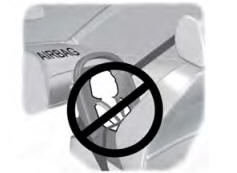Ford Explorer: Climate Control System - General Information / General Procedures - Fluorescent Dye Leak Detection - Vehicles With: R1234YF Refrigerant
Special Tool(s) / General Equipment
| UV Leak Detector | |
| Electronic Leak Detector |
Leak detection
Vehicles with air conditioning
-
Review next note for important refrigerant system dye information.
NOTE: Fluorescent refrigerant system dye is added to the refrigerant system at the factory to assist in refrigerant system leak diagnosis using a Rotunda-approved UV lamp. Do not add dye to the refrigerant system before diagnosing leaks or after repairs, even if a significant amount of refrigerant has been removed from the system. Replacement suction accumulators, receiver driers, receiver drier elements, and service condensers are shipped with a fluorescent dye wafer included in the desiccant bag which dissolves after approximately 30 minutes of continuous A/C operation. Do not add dye after flushing the refrigerant system because a new suction accumulator, receiver drier or receiver drier element is installed as part of the flushing procedure.
Fluorescent Dye Leak Detection
NOTE: Ford Motor Company vehicles are produced with R-1234yf fluorescent dye installed in the refrigerant system from the factory. The location of leaks can be pinpointed by the bright yellow-green glow of the fluorescent dye under a UV lamp. Since more than one leak can exist, inspect each component, line and fitting in the refrigerant system for a leak.
NOTE: Use of dye-enhancing glasses or goggles greatly improves the detection of the dye under the UV lamp.
NOTE: Not all UV lamps will fluoresce the dye used in Ford vehicles. All Rotunda UV lamps are optimized to fluoresce the dye.
NOTE: If the system has been out of refrigerant through the winter the dye at the leak point may have oxidized and may not fluoresce. If this happens, recharge and operate the A/C system to circulate the oil and allow any residual dye to show up at the leak point. It is important to understand that dye adheres to the oil not the refrigerant; the refrigerant carries the oil out of the leak point.
-
Check for leaks using a Rotunda-approved UV lamp and dye enhancing glasses.
-
Inspect all components, lines and fittings of the refrigerant system.
-
After the leak(s) is repaired, remove any traces of fluorescent dye with a general purpose oil solvent.
-
Verify the repair by running the vehicle for a short
period of time and rechecking the area of the leak with a
Rotunda-approved UV lamp.
Use the General Equipment: UV Leak Detector
-
If it is a small leak the dye may take awhile to
reappear a Rotunda-approved electronic leak detector is also suggested
to use. REFER to general procedures Electronic Leak Detection.
Use the General Equipment: Electronic Leak Detector
 General Procedures - Evaporator Core Leak Check - Vehicles With: R1234YF Refrigerant
General Procedures - Evaporator Core Leak Check - Vehicles With: R1234YF Refrigerant
Special Tool(s) /
General Equipment
Air Conditioning Service Unit
Air Conditioning Adaptor Kit
Inspection
Recover the refrigerant...
 General Procedures - Heater Core Leak Check - Vehicles With: R1234YF Refrigerant
General Procedures - Heater Core Leak Check - Vehicles With: R1234YF Refrigerant
Inspection
NOTE:
A coolant leak in the heater hose could follow the
heater core tube to the heater core and appear as a leak in the heater
core...
Other information:
Ford Explorer 2020-2024 Service Manual: Removal and Installation - Front Driveshaft
Materials Name Specification Slip Yoke Grease5L3Z-19A506-A - Removal All vehicles Remove the transfer case. 3.0 and 3.0L EcoBoost - Hybrid Remove Catalytic Converter RH. Refer to: Catalytic Converter RH (309-00B Exhaust System - 3...
Ford Explorer 2020-2024 Service Manual: Removal and Installation - Second Row Easy Entry Power Release Cable
Removal NOTE: LH rear seat shown, RH rear seat similar. NOTE: Removal steps in this procedure may include installation details. Remove the second row easy entry power release actuator. Refer to: Second Row Easy Entry Power Release Actuator (501-10B Second Row Seats, Removal and Installation)...
Categories
- Manuals Home
- 6th Generation Explorer Owners Manual
- 6th Generation Explorer Service Manual
- Description and Operation - Jacking and Lifting - Overview
- Using Tether Straps
- Body and Paint
- New on site
- Most important about car
Children and Airbags
WARNING: Airbags can kill or injure a child in a child restraint. Never place a rear-facing child restraint in front of an active airbag. If you must use a forward-facing child restraint in the front seat, move the seat upon which the child restraint is installed all the way back.

